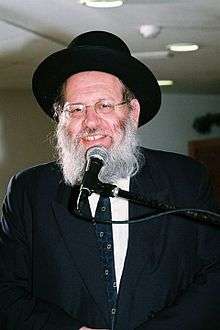David Avraham Spector

Rabbi David Avraham Spektor, also spelled Schpektor (9 Av 5715 – 12 Tishrei 5774) (August 9, 1955 – 16 September 2013) was a Dutch–born Israeli rabbi.[1] He was born in Amsterdam, the Netherlands and emigrated to Israel in 1973, after the Yom Kippur war. Rav Spektor studied at several Yeshivas for ten years, primarily at Yeshivat Merkaz Harav and the Meretz Kollel. He was ordained by the Chief Rabbinate of Israel as both a Neighborhood Rav (Rav Shechunah) and City Rav (Rav Ir).
Rabbinical posts
Rav Spektor held several prestigious Rabbinical and teaching posts:
- Rav of Hebrew University of Jerusalem
- Rav of the Nokdim community in Gush Etzion
- Army Chaplain (Rav Tzva'i ) with the rank of lieutenant in artillery
- Lecturer in Michlelet Emunah college for women in Jerusalem (this last position continued concurrent with his dual service as a rabbi in Beit Shemesh and, when his health allowed him, until his untimely death)
In 5759 (1998), Rabbi Spektor was appointed the Ashkenazic Rav of the Givat Sharett neighborhood of Beit Shemesh.[2][3] He was also appointed to be a member of the local Rabbinate of Beit Shemesh, responsible for Shabbat, Eruv, and Mikva'ot in Beit Shemesh.
Simultaneously, Rav Spektor was elected as the Rav of the Ohel Yonah Menachem congregation in Givat Sharett.
Rav Spektor delivered numerous Torah lessons throughout Beit Shemesh, and always made himself available to answer anyone's halachic and other questions or to counsel or help them in any way he could. Under Rav Spektor's direction, the area enclosed by the community was doubled in size and is now approximately 45 km2. In addition, he supervised the construction of four new Mikva'ot and the renovation of the two existing ones.
Rav Spektor died on 12 Tishrei 5774 (16 September 2013) after a two-year struggle with cancer.
Publications
Rav Spektor has published several books with approbations given by G'dolei Yisrael, including:
- El-David Responsa on actual Halachic questions
- Tahorat Eretz Yisrael discussing ritual purity in halacha and thought
- Torat Eretz Yisrael[4] on the weekly portion
- Sefer HaGabbai
- Beit Shemesh,[5] the Biblical town
- Herodian Responsa
- Drama, Art and Graphic Design Responsa[6]
His wife, Rabbanit Chaya Spektor has also published a book:
- The Value of Childbirth in Jewish Sources
References
- ↑ "Rabbi David Avraham Spektor Passes Away - Jewish World - News". Israel National News. 2013-09-16. Retrieved 2013-09-20.
- ↑ "Teach, don't burn". Jerusalem Post (via HighBeam Research). December 28, 2001. Retrieved 13 August 2012.
- ↑ Singer, Saul (2003-09-30). Confronting Jihad: Israel and the world after 9/11. Cold Spring Press : distributed by Simon & Schuster. p. 252. ISBN 9781593600013. Retrieved 13 August 2012.
- ↑ Lichtman, Moshe D. (2006-12-01). Eretz Yisrael in the Parashah: Essays on the Centrality of the Land of Israel in the Torah : Plus Commentary on Nearly Every Reference to the Holy Land in the Torah. Devora Publishing. pp. 214–. ISBN 9781932687705. Retrieved 13 August 2012.
- ↑ Enkin, Ari N. (2008-05-30). Dalet amot: halachic perspectives. Gefen Publishing. p. 193. ISBN 9789652294098. Retrieved 13 August 2012.
- ↑ Alexenberg, Mel (2011-04-15). The Future of Art in a Postdigital Age: From Hellenistic to Hebraic Consciousness - Second Edition. Intellect Books. pp. 210–. ISBN 9781841503776. Retrieved 13 August 2012.